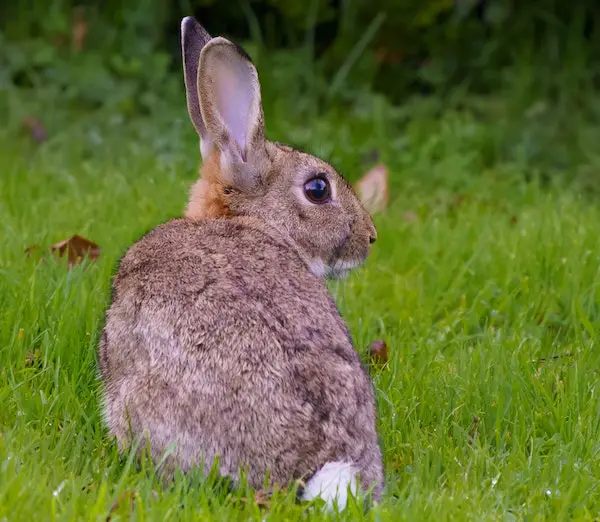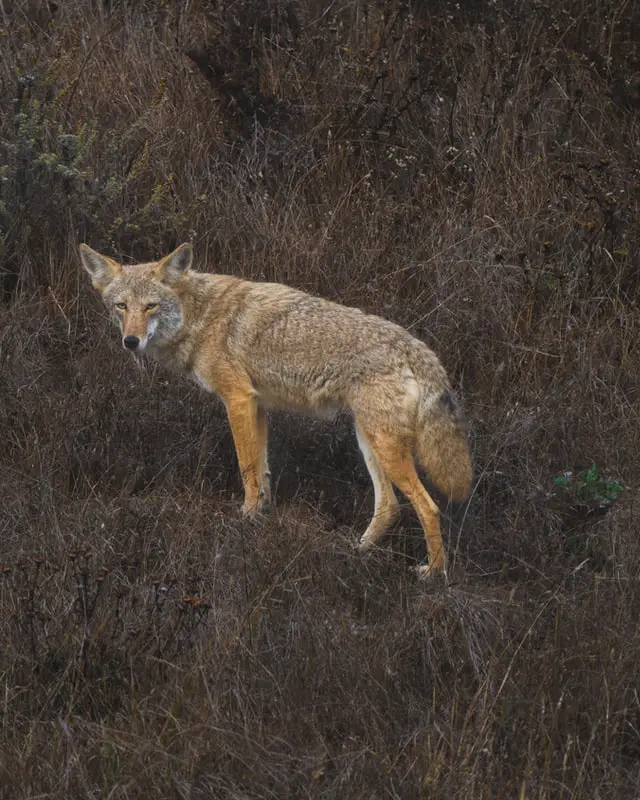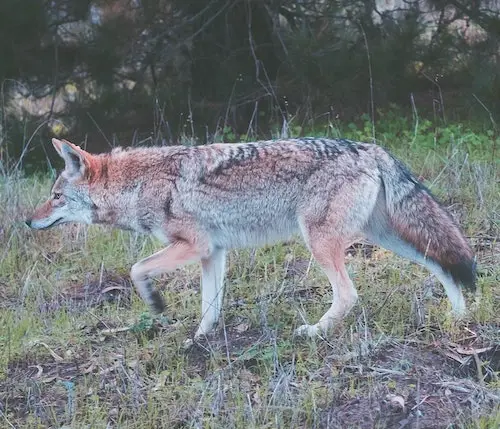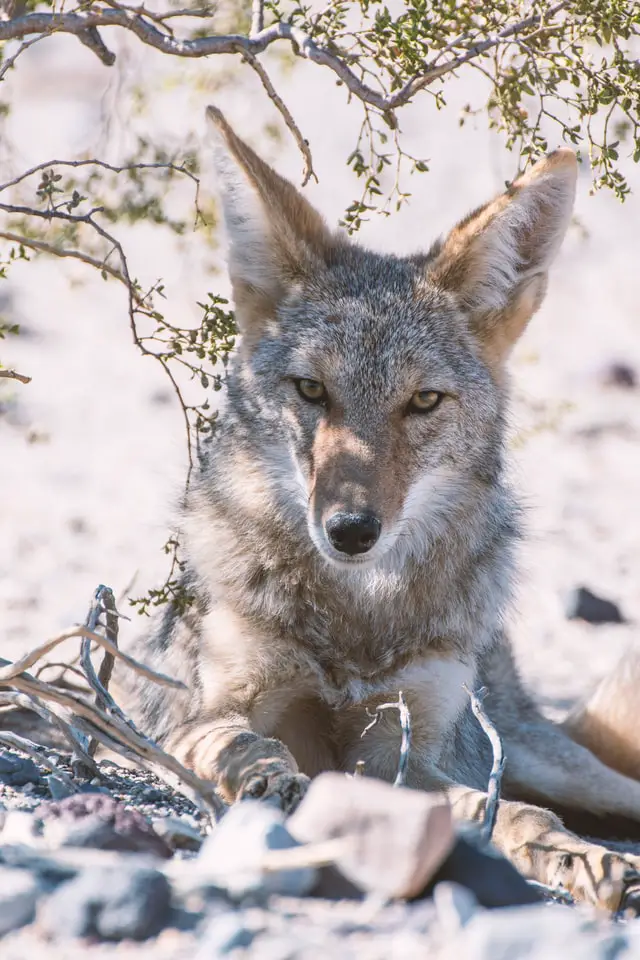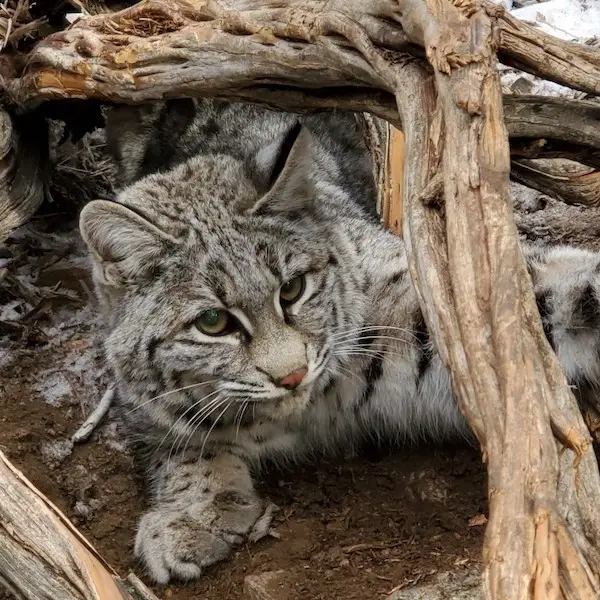What Is a Black Coyote?
Are There Black Coyotes Near Me?
Coyotes (Canis latrans) are one of the most common predators in the United States. They’ll eat almost anything, adapt to any environment, and they’re cunning and resourceful. Their average color is a brown, tan, and gray mix, but other colors exist less frequently, including white, red, or even black. But what is a black coyote?
Related: Coyote Scat: Everything you didn’t want to know.
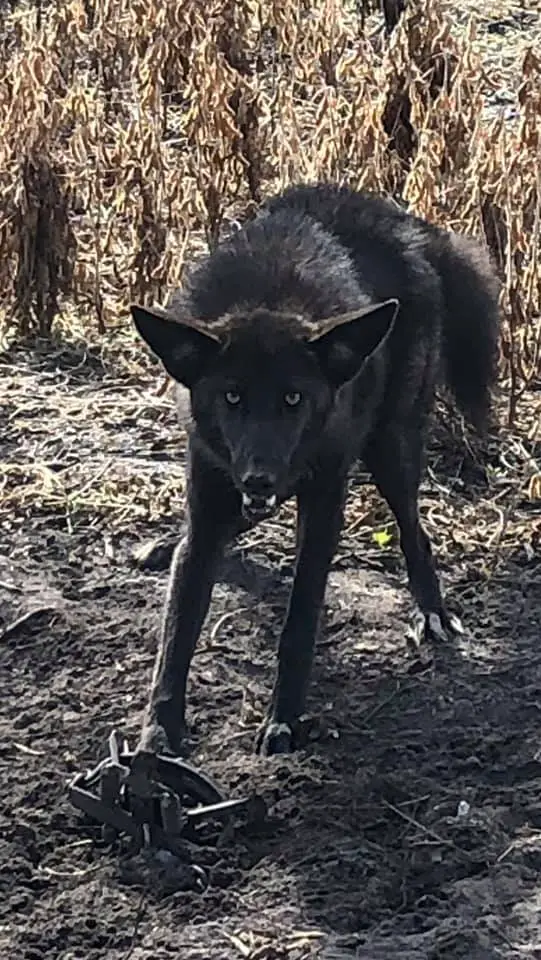
A black coyote has a recessive gene called melanism, occasionally seen in the Southeastern coyote but rarely in other breeds. Melanism is the increased production of black pigment, usually seen as a color variation in animals. Melanin is a dark brown or black pigment appearing in eyes, skin, or hair in animals or people.
What are the breeds of the black coyote?
Surprisingly, not all coyote breeds produce a melanistic (black) coyote. Here’s why. The Eastern coyote has a different heritage. Eastern coyotes are only 64% coyote. The rest of this coyote’s DNA comprises 13% Eastern wolf, 13% gray wolf, and 10% dog. Due to their added genetics, they’re bigger than the Western coyote, more adaptable, weigh more, and more likely to produce a black coyote.
What causes melanism in coyotes?
Melanism is a trait bred into Eastern coyotes through crossbreeding with wolves and then again with the domestic dog. Hybridization repeatedly occurred in the history of the wolf and coyote. However, the melanistic gene happened when the early Native Americans settling the continent brought dogs that crossbred with wolves and coyotes.
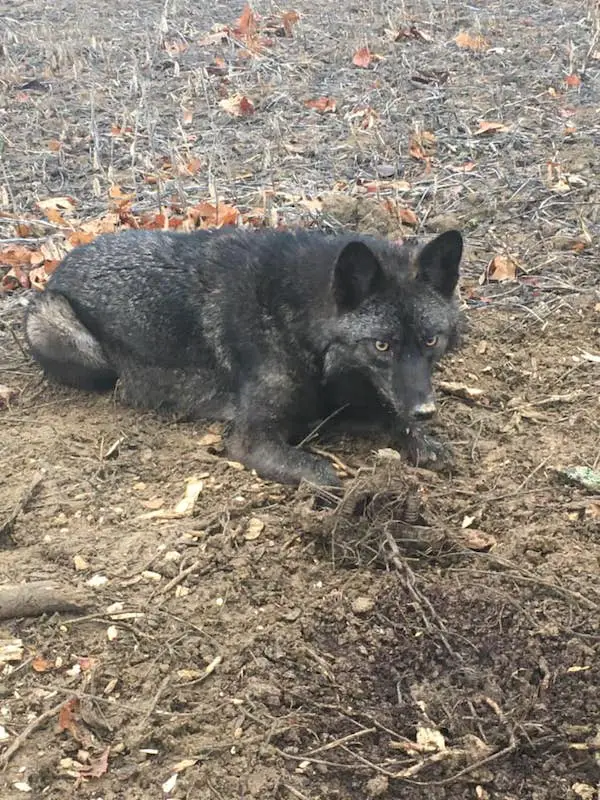
Then about 100 years ago, coyotes again mated with wolves. Finally, about 50 years ago, those coyotes mated with dogs, creating the Eastern coyote – and a higher chance of melanism.
As a side note, wolves and coyotes only crossbreed when there are no mating possibilities around, which is no longer an issue for the Eastern coyote. Both are more likely to kill a dog than mate with one.
What is a black coyote called?
These dark canids are called devil dogs. They’re still coyotes but have a rare fur color or pattern. Because of that, they look meaner. But they’re not.
Are there black coyotes in Florida?
Black coyotes are found more in Florida than in any other state. They’re uncommon in Florida, but not rare. You can find them in other Southeastern states, where they are rare. It’s also rare to find them in Northeastern states, and Western black coyotes are at least as difficult to find. Eastern coyotes have the melanistic gene appear more often.
Related: How High Can a Coyote Jump?
Could we breed a Western black coyote?
You likely cannot breed a Western black coyote unless you have two Western coyotes to mate. Because of the recent wolf and dog cross-breeding into the Eastern coyotes, they’re almost a separate species rather than a sub-species of the coyote. The Eastern coyote most recently crossbred with wolves, and the product of that union crossbred with dogs. While the crossbreeding seems to have affected both the Northeastern and Southeastern coyotes, coloration shows up more often in the Southeastern coyote.
From that, a new variation sprouted and produced two subspecies of coyotes in the Eastern United States: the Northeastern and the Southeastern coyotes. The coloration shows up more often in the Southeastern coyote.
Related: Piebald Raccoon
What does a black coyote symbolize?
In some Native American cultures, the coyote is steeped in symbolism as a spirit guide who helps people in their spiritual quests. In others, it’s seen as a trickster spirit and is known for being cunning and resourceful. However, color does not define the coyote in this culture.
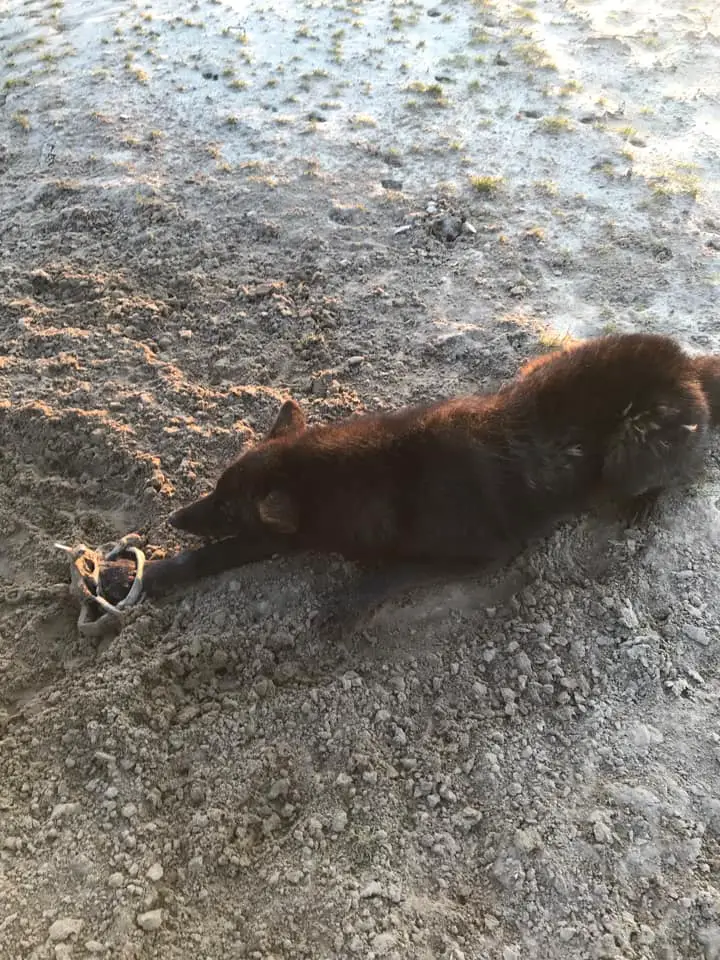
Color has significant meaning in Chinese folklore. The black coyote symbolizes evil, or malevolent forces, while the white represents good omens, good spirits, and angelic energies. In Japanese culture, the black coyote is associated with the moon and is thought to represent wisdom and intuition. In Korean culture, black coyotes represent courage and loyalty.
Western civilizations associate black coyote symbolism with change and new life events. Southern culture views the black coyote as a mysterious and dark magic creature.
Although the coyote is steeped in African mythology, color is not mentioned.
Overall, the meaning of this animal varies depending on the story’s origin, but it’s generally accepted that the black coyote is a harbinger of change and new beginnings.
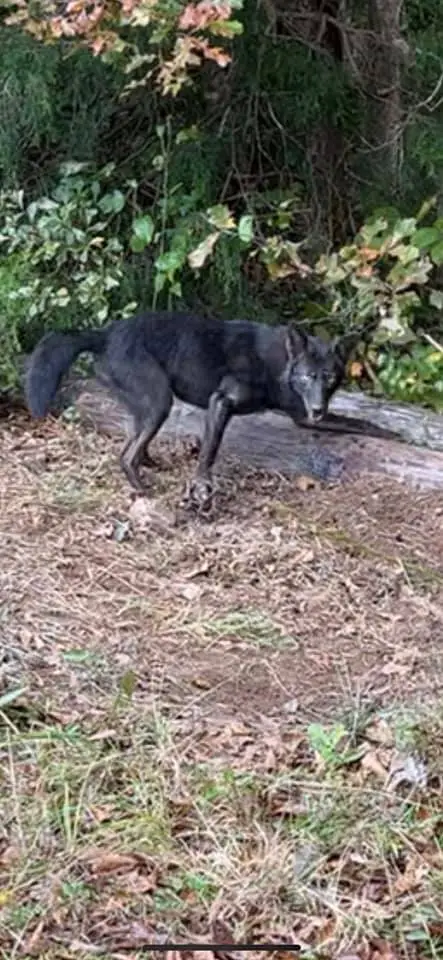
What does a white coyote symbolize?
As with black coyotes, white coyotes have symbolism. The white coyote is an animal spirit in Native American culture. The spirit of the white coyote teaches people how to be good and do the right thing. The white coyote is a mystical creature that brings good luck, which is why they are often associated with gamblers who want to win at craps.
Are black coyotes friendly?
Black coyotes are like any other coyote, and each has an individual personality, color notwithstanding. Some coyotes are simply more social. But, on average, coyotes are wild and want little to do with you.
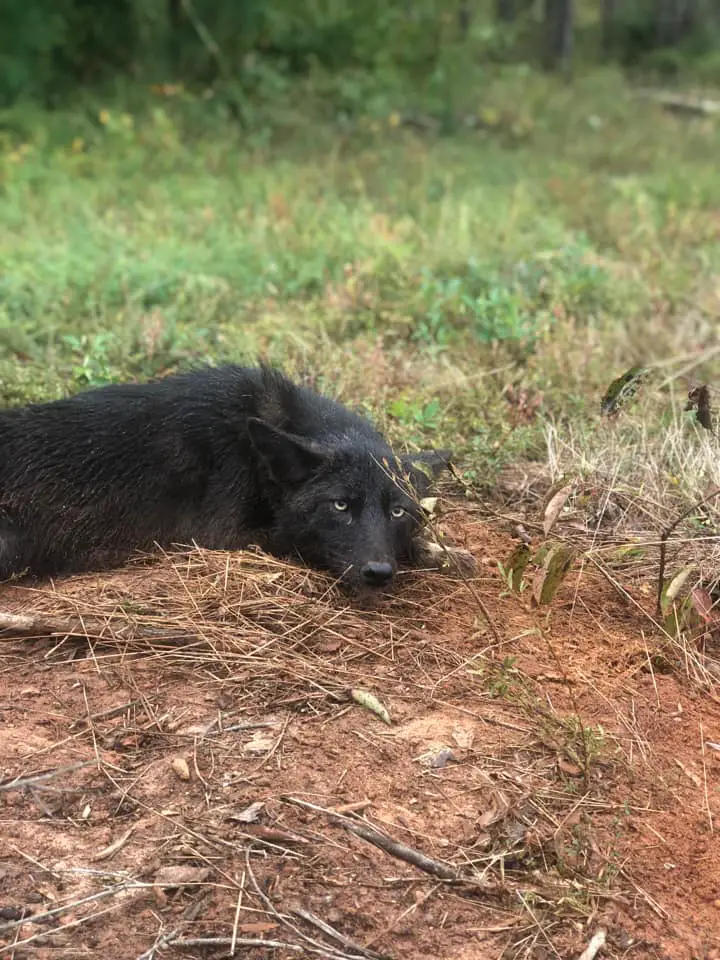
However, some coyotes will approach you and seem to want human companionship. These are the ones that people have fed. When this happens, the coyote loses its fear of people and can become very aggressive.
Coyotes are not pets. Do not feed them. Even if you tame them, the “wild” is never “trained out” of them. They will hunt your (or your neighbor’s) chickens, bring items or prey home to you (which they keep), and eat your cat.
Having said all of that, people do have coyotes as pets. The animals are happy, and the owners are happy. The owners post pictures of their coyote pets.
Unfortunately, living as a house pet to humans does not keep a coyote safe if they leave the property. Hunters and some farmers may still see the house pet coyote as an animal to cull. Coyotes have a high population and a poor reputation. Such opportunistic canids still hunt and steal because those instincts are difficult to ignore.
As for excessive friendliness in some of the black coyotes, the Canine Ancestry Project is looking for genetic markers linking to hyper-social traits. As this is a current research project, there is no further information at this time.
How much is the black coyote pelt worth?
It depends. Southern coyotes live in a warmer climate, so their fur is thinner. A melanistic coyote may not be all black and can also have a lower value there. The average value in the current market for a Southern coyote pelt is $10-$15, while a Northern coyote pelt in good condition is $70-$100. As a black coyote pelt is challenging to find, the value depends on quality, demand, and availability.
Related: How to skin a coyote
What survival advantages do black coyotes have over other coyotes?
Because melanistic coyotes are black, they blend well in shaded environments like forests. They are more difficult to see at night and may be mistaken for other animals or small boulders on the tundra. They may also have the advantage of viral and parasitic resistance in areas of high infection rates due to the Kb allele genome. More about this genome later.
What is the science behind the coyote’s color?
Genetically speaking, the Kb allele causes the black or melanistic coat color. The E allele causes the albino (full white with pink eyes). The Ky allele gives the gray (agouti) coat color.
Like the wolf, the black color (Kb allele) breeds more often in forested habitats and locations.
Can you hunt black coyotes?
Yes. Hunting coyotes have no rules based on color. However, basic predator hunting rules apply to the hunter or trapper looking to bring home a coyote.
What are other coyote colors?
Coyote colors depend on the region, climate, environment, breed, coat density, and genetic mutation. Very few American coyotes are melanistic, and fewer still albinistic (all white). Colors include brown, tan, gray, red, black, white, or, more likely, a mixture of any and all of these.
When seasons change, so do the coyote coats and colors. Eastern coyotes shed for the warmer months, narrowing coat colors down to red, gray, and tan for a thinner coat. Coyotes have more coloring in those cold winter months with the heavier coat. Dark brown is common, with gray, salt-and-pepper, and smatterings of reddish shades. They can maintain lighter tan colors as well.
What color are the different body parts of this animal?
The legs of a coyote usually have black markings or lines visible on the front. Their face, like behind the ears and cheeks and hair behind the nose, are chestnut or reddish. However, a melanistic coyote is more likely to be all black or very dark over most of its body.
Are the eyes red?
The eyes will be yellow or, more commonly, brown in a black or melanistic coyote. The eyes are normally yellow in the most common color mix of tan, gray with reddish tones, or even salt pepper. Even in a white coyote, the eyes are yellow.
However, in an albino coyote, the skin under the hair is pink, and the eyes will always be pink or red. Although it is uncommon to see a white coyote, it is extremely rare to see an albino. It is far rarer to see an albino coyote than it is an entirely black melanistic coyote.
Coyotes’ eyes shine bright at night when you point a light at them. This is because they have reflective eyes and night vision.
What are the odds of passing on the melanism?
The black color of a coyote is heritable. Melanism is a dominant allele that appears about 50% of the time. Depending on how it shows up, the black coloring may appear in half the litter or more in coyotes living in forested areas and less in locations with fewer shaded or covered areas.
Do they see differently because of their color?
Coyotes are color blind. They can see yellow and blue, but red is gray to them. They see patterns, but colors are a weakness for them. Coyotes are also near-sighted with 20/70 vision but 260° peripheral vision. Humans have 180° peripheral vision.
Like humans, albino coyotes will have more eye problems due to a lack of pigmentation. It causes the eyes to develop abnormally, called macular hypoplasia. Other coyotes have normal coyote eyesight, even melanistic ones.
How rare is this animal?
The black coyote is rare – only 2% of these creatures are melanistic. The albino coyote is ultra rare. Out of 160,000 coyotes recorded, only 6 were true albino. That’s 0.00375%
What symptoms does this color cause besides color?
Melanism is more than just color. For example, black coyotes have an advantage when hunting at night since they are more camouflaged. Therefore, they have a better chance of survival.
But that’s not all. A chemical called tyrosine produces melanism, which may also be responsible for melanin synthesis in the immune defense. The gene may even defend against distemper.
What is the lifespan of the black coyote in the wild and captivity?
Coyotes can live up to 14 years in captivity or domesticated, but the average lifespan of a coyote in the wild is only 5-6 years. While the black color adds camouflage in the dark, hunters attach value to the rare find of a melanistic canid.
So a black coyote can have a comparable lifespan to coyotes with common coloring. As with any animal, the black coyote may be hunted, protected, or simply observed. Many people post videos of black coyote sightings from webcams, or you can buy one of your own and post them for others.
Where can I see a black coyote?
You can see pictures and a video of a black coyote here. Watch another video here. Read about the black coyote journey in San Francisco here. If you want to see one in person, you’re more likely to find one in the country’s Southeastern part.
It’s a state law in Georgia that if you capture a coyote, you must euthanize it. However, the Atlanta Coyote Project keeps a black coyote in captivity. They captured the coyote because of its overly-friendly tendencies toward family dogs and consistent visits to people’s homes. They had to obtain special permission to capture the animal without euthanizing it.
Finding a black coyote
You can find black coyotes all over the United States, but more likely in the country’s Southeastern part, like Georgia and Florida. The Eastern coyote breed has more black coyotes because they recently underwent another crossbreeding around 100 years ago. As black coyotes increase in population, we may see them more often. Right now, they’re rare, but as there may be evidence of increased immunities and improved camouflage, black coyotes may have a higher chance of long-term survival compared to the common tan and gray coats. Although lifespans are relatively short compared to coyotes co-existing with humans in homes, melanism may increase life expectancy in the long term.
Sources:
- Adaptability (joynumber.com)
- Biologists solve mystery of black wolves | EurekAlert!
- Coyote (Canis latrans) (texas.gov)
- Coyote Coat Color Genetics (sasktelwebsite.net)
- Eastern Coyote Wildlife Note (pa.gov)
- How Albinism Affects Vision (lensshopper.com)
- https://www.ncbi.nlm.nih.gov/pmc/articles/PMC2903542/
- Eastern Coyote Genetics
- https://www.providencejournal.com/story/news/2017/11/17/eastern-coyotes-already-part-wolf-showing-increasingly-wolflike-traits/17018820007/
- https://theconversation.com/yes-eastern-coyotes-are-hybrids-but-the-coywolf-is-not-a-thing-50368
- K-KB Locus Genetic Test | GenSol Diagnostics (gensoldx.com)
- melanism | Coyote Yipps
- Melanism of Coyotes (Canis latrans) in Florida.: EBSCOhost
- Melanistic-Coyotes-in-Northwest-Georgia.pdf (secureservercdn.net)
- Melanism in Coyotes – Atlanta Coyote Project
- Molecular and Evolutionary History of Melanism in North American Gray Wolve…: EBSCOhost
- Natural Selection and Origin of a Melanistic Allele in North American Gray Wolves – PMC (nih.gov)
- New World Wolves and Coyotes Owe Debt to Dogs – The New York Times (nytimes.com)
- Seeing A Coyote Meaning Spiritual Symbolism – Symbolizes Playfulness, What Does It Mean When You See A Coyote? Meaning & Symbolism – About Spiritual
- Yes, Eastern Coyotes Are Hybrids, but the ‘Coywolf’ Is Not a Thing | SciTech Connect (elsevier.com)
- Immune defence, a possible nonvisual selective factor behind the industrial melanism of moths (Lepidoptera) — University of Helsinki
- Caudill, G., & Caudill, D. (2015). Melanism of Coyotes (Canis latrans) in Florida. American Midland Naturalist, 174(2), 335–342. https://doi.org/10.1674/0003-0031-174.2.335
- Anderson, T. M., VonHoldt, B. M., Candille, S. I., Musiani, M., Greco, C., Stahler, D. R., Smith, D. W., Padhukasahasram, B., Randi, E., Leonard, J. A., Bustamante, C. D., Ostrander, E. A., Hua Tang, Wayne, R. K., & Barsh, G. S. (2009). Molecular and Evolutionary History of Melanism in North American Gray Wolves. Science, 323(5919), 1339–1343. https://doi.org/10.1126/science.1165448
- Mikkola, K., & Rantala, M. J. (2010). Immune defence, a possible nonvisual selective factor behind the industrial melanism of moths (Lepidoptera). Biological journal of the Linnean Society, 99(4), 831-838. https://doi.org/10.1111/j.1095-8312.2010.01398.x
Beth Criman one of our writers worked on this article. You can become a writer for THF Outdoors follow this link.



